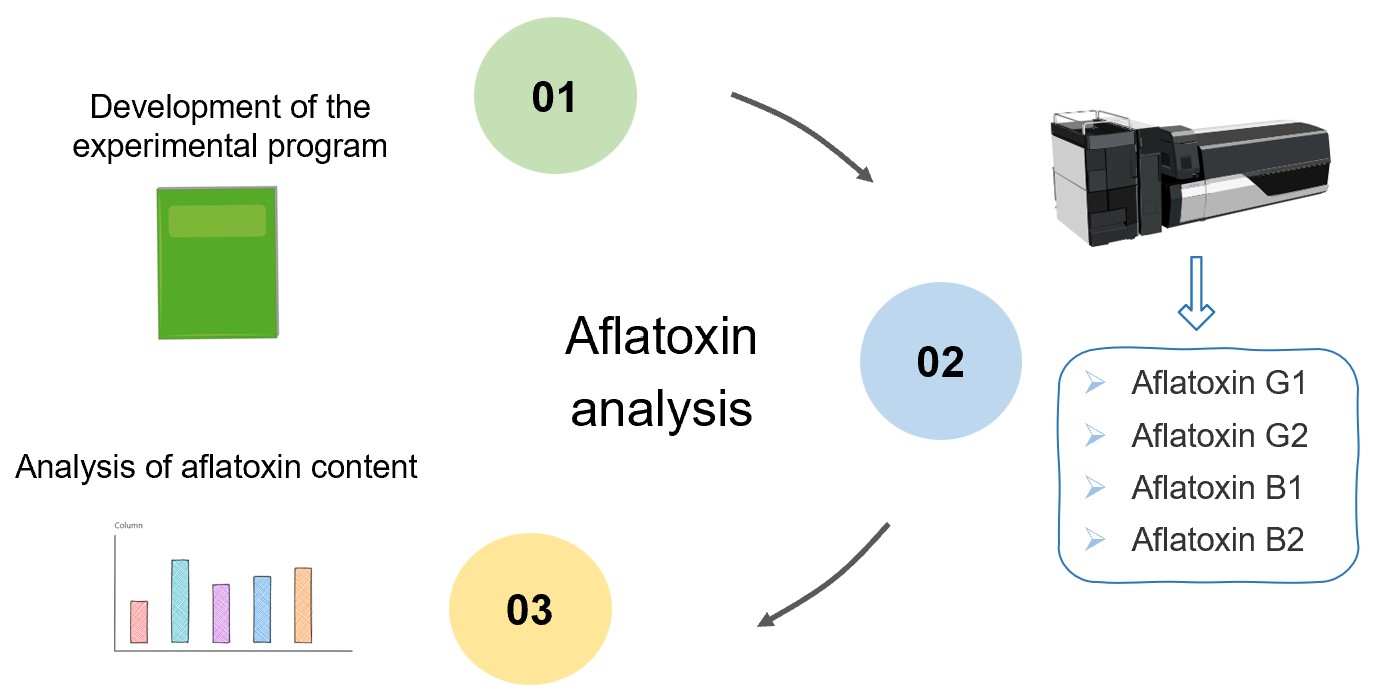Aflatoxin Profiling Service
Power Your Research with Aflatoxin Analysis
Biomasses such as seaweeds contain various Fatty Acids, Phytohormones, Vitamins, etc., which have good application prospects. Detection of toxic substances such as aflatoxin is essential for assessing the quality of Biomass such as Seaweeds and for application studies such as food. Creative Biolabs provides a reliable aflatoxin analysis service according to excellent and stable analytical systems. Our analytical methods for detecting aflatoxin in various types of biomass, such as seaweed, provide reliable results by combining high sensitivity with good performance.
Aflatoxin is a toxic secondary metabolite produced by certain fungi that can contaminate a wide range of biomass including seaweed. We design individualized solutions to detect aflatoxin in different samples. The treatment of different samples may vary.

Liquid chromatography-mass spectrometry (LC-MS): We use optimized LC-MS to detect aflatoxin in various types of biomass, which combines the physical separation properties of LC with the analytical capability of MS. The method is validated to give accurate analytical results to the client. Moreover, the method is sensitive, reproducible, and easily realizes the trace detection of aflatoxin in samples.
Based on an efficient and reliable LC-MS analysis system, we detect the following four aflatoxins in various types of biomass samples:
-
Aflatoxin G1
-
Aflatoxin G2
-
Aflatoxin B1
-
Aflatoxin B2
Features of Aflatoxin Analysis Service
-
Efficient analysis technique: We use advanced LC-MS techniques to analyze various aflatoxin levels.
-
Experienced experts: We have a team of experienced scientists and technicians for various types of analysis such as aflatoxin. They have in-depth knowledge of seaweed analysis.
-
Fast analysis: LC-MS technology is highly sensitive and fast, which greatly shortens our analysis cycle.
Creative Biolabs is a reliable and trustworthy partner when it comes to analyzing biomass such as seaweed. We provide an efficient and professional aflatoxin analysis service to support researchers and companies to better analyze the quality and applications of biomass such as seaweed. Welcome to contact us to learn more about our aflatoxin analysis service and tell us your needs if you are interested in our service.
Published data
Sargassum sp has a wide range of bioactive compounds with applications in food and industry. In this study, different treatment methods were used to prepare Sargassum sp into seaweed tea, and the effects of these methods were compared. The researchers found that the seaweed tea prepared by different methods did not contain aflatoxin and met the requirements of herbal tea. The one-minute hot blanching treatment was more effective and retained more active ingredients. This study provides a demonstration for us to detect and analyze aflatoxins in seaweed products.1, 2
FAQs
Q1: What types of aflatoxins are typically analyzed during biomass research?
A1: Aflatoxins are secondary metabolites produced by fungi, and there are four main types of aflatoxins: aflatoxin B1, aflatoxin B2, aflatoxin G1, and aflatoxin G2. These four types of aflatoxins are usually analyzed during the research of biomasses such as maize, wheat, and seaweed.
Q2: What are the techniques to detect and quantify aflatoxins?
A2: There are various techniques for the detection of aflatoxin content, such as thin-layer chromatography, LC-MS, immunoassay, etc. These methods are sensitive and specific for the detection of aflatoxin.
Customer Review
Trusted Partner
"Creative Biolabs was a very trustworthy partner. We appreciated their transparency about the technology they used and their commitment to accuracy. Their staff was very professional and knowledgeable. After the aflatoxin analysis, we were also given some valuable advice on analyzing the test results, which helped us to analyze the samples more accurately."
Proper Handling
"We liked the professionalism and quality of the aflatoxin analysis service by Creative Biolabs. They made a proper treatment plan based on our samples and used advanced techniques to analyze aflatoxin levels. We were very satisfied with the analytical results and overall service experience."
References
-
Sinurat, E., J. Basmal, and T. D. Suryaningrum. "The effect of blanching toward chemical properties and sensory quality of brown seaweed Sargassum Sp. Tea." IOP Conference Series: Earth and Environmental Science. Vol. 292. No. 1. IOP Publishing, 2019.
-
Under Open Access license CC BY 3.0, without modification.
For Research Use Only.
Related Services



